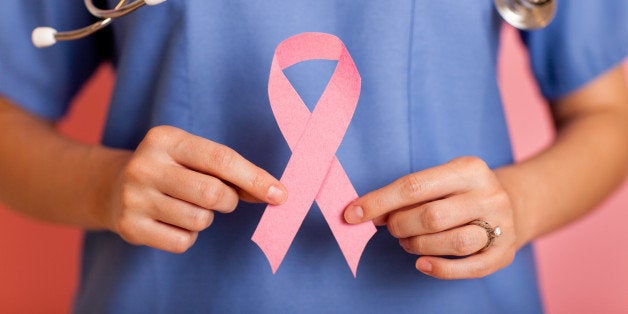
Forty years ago, when two women -- Betty Ford and Margaretta (Happy) Rockefeller -- went public with their diagnoses of breast cancer, it was historic. In contrast to our modern era, which encourages women with the disease to tell their stories, breast cancer remained a quiet subject in the 1970s.
Yet despite these women's courageous acts, their legacies remain more complicated. Indeed, Ford's cancer disproved the specific lessons her case had supposedly taught. As we continue to struggle with breast cancer and additional celebrities go public, it is worth revisiting what we have really learned.
Ford was not the first famous woman to tell her story. Shirley Temple Black had revealed details of her diagnosis and mastectomy in 1973. But Ford was the First Lady -- the wife of President Gerald R. Ford -- when her doctor discovered a lump in her right breast on Sept. 26, 1974.
It would certainly been possible at the time for Ford to have quietly undergone surgery without informing the press. But she felt strongly that the public deserved to know. Thus, newspapers across the country on Sept. 29 described in great detail the radical mastectomy that Ford had undergone the previous day [1].
Public outpouring was enormous. Ford received over 50,000 pieces of mail, many from other women with breast cancer [2] .
Ford's lesson for other women was straightforward: get a mammogram, which she had not done. The American Cancer Society and National Cancer Institute had recently mounted a demonstration project to promote the detection of breast cancer as early as possible, when it was presumed to be more curable.
The degree to which women embraced Ford's message became clear through the famous "Betty Ford blip." So many women got breast examinations and mammograms for the first time after Ford's announcement that the actual incidence of breast cancer in the United States went up by 15 percent.
But Ford's case was a classic example of how early detection often did not matter. Her cancer was large enough to be felt on a physical exam. Moreover, she had three positive lymph nodes in her right underarm, indicating spread of the disease. Ford's cancer was not at all early [3].
Yet probably because she was among the earliest women to receive chemotherapy for cancer localized to the breast and lymph nodes, Ford survived. Her tumor had been very sensitive to the medication.
But women who pursued mammography in the wake of Ford's diagnosis remained certain that their breast cancers -- if detected -- would be curable. "I thank God and you that I found it in time," one woman wrote to Ford in December 1974. "Without you, I may have been too late" [4].
To say that we are still struggling with the value of early detection is an understatement. Despite substantial data from randomized controlled trials and meta-analyses indicating that mammography, particularly for women under 50, saves few, if any, lives, breast cancer narratives typically attribute survival to mammography. While such accounts are both inspiring and hopeful, they -- like Betty Ford's story -- use pieces of information to create a coherent narrative after the fact.
It was Ford's experiences that induced Rockefeller, the wife of vice-president designate Nelson Rockefeller, to examine her own breasts. She found a lump and, only a few weeks after Ford, had a modified radical mastectomy for a left-sided cancer.
Rockefeller's surgeon at Memorial Sloan-Kettering Cancer Center, Jerome Urban, was especially aggressive in his treatment of breast cancer. In order to find potential cancers, he performed what he called "mirror image biopsies" -- removing a piece of tissue in the unaffected breast that corresponded to the location of the cancer on the other side. He did so because his data showed that 15 to 20 percent of such women would have either cancer or abnormal cells, known as carcinoma-in-situ (CIS) [5]. It was another form of early detection.
When Urban found CIS in Rockefeller's second breast, he recommended she have it removed as well. Even though there was no actual cancer there, she was at higher than average risk for it in the future. Identifying and treating CIS as early as possible, one of Urban's colleagues wrote, was "catching breast cancer as early as possible" [6]. Rockefeller agreed and had a second mastectomy.
Today, prophylactic mastectomies are on the rise, both for women with breast cancer and those at risk for the disease. No one disputes the use of these procedures for those with either a BRCA1 or BRCA2 mutation, which convey a lifetime risk of developing breast cancer as high as 85 percent. A celebrity who opted for double mastectomy in this circumstance was the actress Angelina Jolie. However, growing numbers of women without these mutations but with breast cancer, CIS or other risk factors are now requesting -- and obtaining -- mastectomies. Yet none of these procedures has ever been shown to prolong survival.
Just as Betty Ford's survival was not due to early detection, Rockefeller's survival (she turned 88 in June 2014) unlikely resulted from the prophylactic removal of her second breast. Early detection of breast and other cancers remains a complicated and controversial subject. While we applaud the courageous acts of these women 40 years ago, we should remember that celebrity illnesses can both inform and misinform.
References:
1. Marjorie Hunter, Ford's Wife Undergoes Breast Cancer Surgery, The New York Times, September 29, 1974, p. 1.
2. Barron H. Lerner, The Breast Cancer Wars, New York: Oxford, 2003, p. 173.
3. Barron H. Lerner, The Breast Cancer Wars, New York: Oxford, 2003, p. 173.
4. Barron H. Lerner, The Breast Cancer Wars, New York: Oxford, 2003, p. 187.
5. Barron H. Lerner, The Breast Cancer Wars, New York: Oxford, 2003, p. 174.
6. Barron H. Lerner, The Breast Cancer Wars, New York: Oxford, 2003, p. 200.